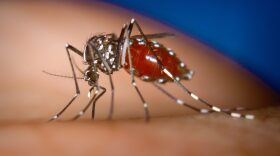Since the 1960s, bee scientists have been baffled by one of the preserved specimens in the Bishop Museum on Oʻahu. The species, Hylaeus tuamotuensis or Tuamotu’s masked bee, was found in French Polynesia in the 1930s.
But its nearest known relatives at the time lived in Australia, New Guinea and New Zealand. So just how did that bee travel nearly 2,000 miles across the open ocean to end up on a handful of Pacific Islands?
A new scientific study resolves the longstanding mystery. It also documents eight newly discovered species of masked bee in Fiji, Micronesia and Polynesia.
The Conversation talked to lead study author James Dorey of the University of Wollongong. His bee research was published in the journal "Frontiers in Ecology and Evolution" earlier this week.
This interview aired on <i>The Conversation</i> on Feb. 28, 2024. The Conversation airs weekdays at 11 a.m. on HPR-1.






